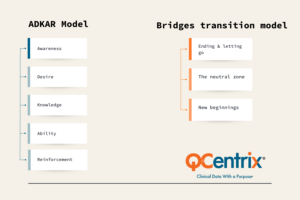Part one of Q-Centrix’s three-part guide to deliberate change management in healthcare
Search for change management strategies online, and you will find many solutions ranging from 8-step models to academic theories and business-driven frameworks. While the solutions seem infinite, 70% of change management efforts still end in failure.
Change management within the healthcare environment presents challenges that are too complex to be solved with a predetermined process. Can those strategies provide guidance? Absolutely, but they are tools, not roadmaps. Like any tool, consideration to determine which device at which time is critical.
Key takeaways:
- Even the most popular change strategies do not work by themselves.
- Deliberate consideration is the key to enabling transformative change – from understanding the value and deciding on a direction to communicating the change and developing leaders who implement it.
- As change challenges the healthcare industry, cultivating effective deliberation becomes the only permanent competitive advantage.

Why change strategies don’t work alone
1. Removing the unexpected effects of change is impossible.
Over 20 years in healthcare have earned Raghu Bukkapatnam, chief growth officer for Q-Centrix, a healthy respect for the power of change. Mastering the unintended consequences inherent in any change has been his most important learning.
“The first core principle of change management for me is – have we been deliberate enough in thinking through the ramifications of change? Have we made sure to examine all the traps of making a decision? Once we have put in that deliberation, the actual change process becomes much easier.”
The healthcare ecosystem is so interconnected that the scope or impact of change is only understood once results are measured, and interdependencies are observed. Typically, the effects of any change include unintended consequences. For example, consider the current labor shortage. During the onset of COVID, services within hospitals across the country were paused, revenues plummeted; and ultimately, decisions were made to cut at least 1.4 million healthcare jobs in April 2020.
While perhaps a necessary step, few predicted how this change would strain the future labor market. Experienced individuals retired earlier than expected; others found new positions or careers outside healthcare. Finding qualified talent – especially for niche positions – is now a common struggle for organizations nationwide. This is not to say that healthcare leaders made the wrong decisions in 2020, but it does demonstrate the non-linear path of change.
2. The current rate of change outpaces management processes
Kotter’s theory is popular among change managers. It focuses on obtaining buy-in from key stakeholders. It also provides clear steps to guide the change process:
- Create urgency
- Build coalition
- Create vision
- Communicate vision
- Empower others
- Create quick wins
- Build on the change
- Embed the change
But what happens when circumstances change in the middle of step four? What comes after step eight to help sustain change through tumultuous times? While the theory is sound, it does not provide the agility healthcare leaders need when new challenges occur every week.
Lewin’s model is another widely accepted model for change:
- Unfreeze: preparing for the desired change
- Change: Implementing the desired change
- Refreeze: Solidifying the desired change
This model focuses on behaviors and can accrue support when dramatic changes are needed. However, the same factors that make this model helpful also limit its usefulness. A radical shift in workflows could be fraught with the risk of employee churn, especially as health worker burnout rates increase. The lack of flexibility after the refreezing stage gives no chance for workers to reflect on what is working well or to improve upon processes in the wake of unforeseen challenges. The result is a half-finished change process that frustrates team members.
While tools like Kotter’s theory and Lewin’s model can be a practical starting point, they will not handle the deliberate thinking required to anticipate external factors and manage change safely.
3. Knowing what to do is different from learning how to execute.
Too many change models offer a process to follow, but no ability to develop a complete change strategy; change grounded in strategy is essential to drive effective implementation across the enterprise.
The ADKAR change management model – outlined below – is excellent for providing a practical approach focused on outcomes. However, a lack of sophistication makes it less helpful in understanding the specifics of change.
While not a change management framework, The Bridges Transition Model is often used to factor in the emotional response to change. Even more appealing, it claims to address these concerns in just three simple steps. But emotions are complex, and trying to work everyone through the same three steps without understanding how to do so is counterproductive.

Why these shortcomings matter
While each model offers value to the change management process, they also lack opportunities to carefully consider the strategy behind the change. As demands for transparency and efficiency increase while revenue and workforce engagement decrease, healthcare systems will be forced to change. For experts like Raghu, the necessary changes are too significant to be solved with the same eight steps.
“Because of everything that’s swirling around us, I would say now there’s an even bigger burden – an even bigger bonus really – of taking a deliberate and measured approach that includes a long-term strategy.”
What to look for in effective change management – deliberate consideration
Skipping steps in the change process, or simply not giving each step the attention it deserves, can be tempting in the fast-paced world of healthcare.
In a recent Syntellis Performance Solutions and Wakefield Research survey, 56% of the 200 hospital executives surveyed said they only plan ahead by one quarter or less. This appears logical initially – the stakes have never been higher, and executives feel the pressure to move fast. However, Raghu advises that transformative change requires a plan designed to last much longer – through both difficult and prosperous times.
“This balance of being super deliberate about how we do things is important to change. Being deliberate in the beginning allows you to remain consistent with your execution during changing times and increase the longevity of your plan. If the strategy has a sound foundation, it will continue to execute far into the future, and a large change is not warranted.”
So how can leaders improve their early-stage decision-making and the success rate of their change initiatives? A great place to focus is the three factors of lasting change outlined by the Harvard Business Review: “The catalyst for transformation, the organization’s underlying quest, and the leadership capabilities to see it through.”
1. Understanding the value-adds that trigger change
Leaders make strategic changes to add value to their organization by improving efficiency or driving growth. Where most efforts fail is prioritizing one over the other. Heavy-handed streamlining can improve short-term productivity but also drain morale and eliminate the resources needed to drive future growth.
“No one has a crystal ball to tell them how long new circumstances will last. But you must realize that eventually, that pendulum is going to swing the other way again. You need to be ready for that.”
Discipline between short-term efficiency and long-term growth is vital when choosing which transformations to pursue. Deliberate evaluations of the primary catalyst for the transformation and the change’s impact allow leaders to develop plans around the total value and mitigate collateral damage.
“You hear in the news that companies are cutting costs and firing people – we are not doing any of that. We are a growth-focused organization, we have a cushion, and we know that, eventually, things will stabilize. At that point, we do not want to get caught flat-footed and not be able to take advantage of the growth that may come on the back end. So, we keep our strategy and focus because our thought process was deliberate enough to last.”
Unlocking consistent change management success is now the most critical initiative for healthcare.
As the rapid pace of change continues to shrink the lifecycle of business strategies, the only lasting advantage healthcare organizations can hope to create is the ability to make effective and agile transformations.
The deliberate decision-making outlined here enables elite transformation by prioritizing measured unity and strategy over speed, hierarchies, frameworks, or any of the countless competing urgencies executive leaders juggle. From preparation to implementation, the impact of unity created through deliberation allows all other aspects of change management to fall into place.
***
Thanks for reading part one of our three-part series on creating deliberate change in healthcare. Part two will cover the enterprise-wide factors leaders should consider when choosing the direction of change. Part three will walk through the strategies and the teams necessary for communicating change across a healthcare organization.